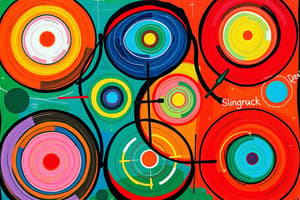Podcast
Questions and Answers
What characterizes negative, destructive feedback?
What characterizes negative, destructive feedback?
- It encourages further exploration of the idea.
- It builds on the strengths of the proposal.
- It provides an explanation for why the idea is bad.
- It tells the receiver their idea is bad without explanation. (correct)
Which feedback type starts with a positive statement but ultimately leads to a negative critique?
Which feedback type starts with a positive statement but ultimately leads to a negative critique?
- 'Yeah, but ...' (correct)
- 'No, because ...'
- 'Yes, and ...'
- 'No' feedback.
What does 'Yes, and ...' feedback aim to achieve?
What does 'Yes, and ...' feedback aim to achieve?
- It dismisses the proposal completely.
- It aims to point out only the flaws of the idea.
- It seeks to identify the strengths and build upon them. (correct)
- It provides a harsh critique to improve the idea.
According to the given content, what is often a drawback of groups making decisions?
According to the given content, what is often a drawback of groups making decisions?
Which approach is suggested to encourage better learning when providing feedback?
Which approach is suggested to encourage better learning when providing feedback?
Which feedback type is characterized by providing the correct answer after pointing out a mistake?
Which feedback type is characterized by providing the correct answer after pointing out a mistake?
What is a potential consequence of negative feedback in collaborative settings?
What is a potential consequence of negative feedback in collaborative settings?
What concept does 'appreciative inquiry' relate to in feedback?
What concept does 'appreciative inquiry' relate to in feedback?
What is the effect of justifying one's actions after apologizing?
What is the effect of justifying one's actions after apologizing?
Which phrase should be avoided in an effective apology?
Which phrase should be avoided in an effective apology?
What is the primary reason to avoid the word 'but' in an apology?
What is the primary reason to avoid the word 'but' in an apology?
Why is asking for forgiveness rarely effective?
Why is asking for forgiveness rarely effective?
What can diminish the value of an apology?
What can diminish the value of an apology?
What type of lie can be considered a 'white lie'?
What type of lie can be considered a 'white lie'?
What must accompany an honest apology to be truly valuable?
What must accompany an honest apology to be truly valuable?
Why do people tend to lie in specific situations?
Why do people tend to lie in specific situations?
What is the anchor point in Social Judgement Theory?
What is the anchor point in Social Judgement Theory?
Which factor is likely to lead to a long-term change of opinion according to Social Judgement Theory?
Which factor is likely to lead to a long-term change of opinion according to Social Judgement Theory?
What challenge does ego involvement present in changing opinions?
What challenge does ego involvement present in changing opinions?
What is one effective strategy for apologizing?
What is one effective strategy for apologizing?
Which statement best aligns with the concept of the anchor point in Social Judgement Theory?
Which statement best aligns with the concept of the anchor point in Social Judgement Theory?
What role does 'room for manoeuvre' play in the context of opinion change?
What role does 'room for manoeuvre' play in the context of opinion change?
Why might a person change their opinion on a sensitive issue like the death penalty?
Why might a person change their opinion on a sensitive issue like the death penalty?
Which factor is least likely to influence a person's deeply ingrained attitudes?
Which factor is least likely to influence a person's deeply ingrained attitudes?
What is the primary concern of Harold D. Lasswell's model when analyzing communication?
What is the primary concern of Harold D. Lasswell's model when analyzing communication?
In the context of media analysis, what does the term 'control analysis' refer to?
In the context of media analysis, what does the term 'control analysis' refer to?
According to Uses and Gratifications Theory, how does media consumption occur?
According to Uses and Gratifications Theory, how does media consumption occur?
What aspect does the 'audience analysis' focus on in Lasswell's model?
What aspect does the 'audience analysis' focus on in Lasswell's model?
What does the question 'which channel?' in Lasswell's formula aim to analyze?
What does the question 'which channel?' in Lasswell's formula aim to analyze?
What does the escalation of marketing and PR tactics suggest about communication in media?
What does the escalation of marketing and PR tactics suggest about communication in media?
What is a common outcome of media presentation that utilizes manipulation and exaggeration?
What is a common outcome of media presentation that utilizes manipulation and exaggeration?
What does the term 'effect analysis' in Lasswell's model aim to determine?
What does the term 'effect analysis' in Lasswell's model aim to determine?
What is the primary focus of intercultural communication?
What is the primary focus of intercultural communication?
Which of the following best describes linear-active communicators?
Which of the following best describes linear-active communicators?
What characterizes multi-active communicators?
What characterizes multi-active communicators?
Which group is described as reactive in communication?
Which group is described as reactive in communication?
How does Richard D. Lewis categorize cultural communication styles?
How does Richard D. Lewis categorize cultural communication styles?
What did Jean Piaget refer to as 'egocentric speech'?
What did Jean Piaget refer to as 'egocentric speech'?
Which type of self-talk is commonly used to improve concentration?
Which type of self-talk is commonly used to improve concentration?
In which context do multi-active communicators conduct their conversations?
In which context do multi-active communicators conduct their conversations?
Study Notes
Four Types of Feedback
- Negative, destructive feedback: Simply stating an idea is bad, without an explanation or alternative, rarely changes behaviour.
- Negative, constructive feedback: Telling someone they are wrong and then giving them the right answer.
- Positive, destructive feedback: Starting with positive aspects of an idea and then criticizing it, providing a contrary opinion.
- Appreciative response: Identifying a positive aspect of a proposal and building upon it. This aligns with "appreciative inquiry" which emphasizes focusing on strengths and potential rather than weaknesses.
Group Decision Making
- While group decision-making is often celebrated, groups can sometimes make poor decisions.
- Cultural differences in communication:
- Linear-active: common in Western Europe and the USA, direct, focused on facts, and prefer written communication.
- Multi-active: common in Mediterranean and Saudi Arabia, emotional, prioritize spoken communication, and can multitask.
- Reactive: common in Japan, China, and Korea, indirect, prioritize face-to-face communication, and defer to authority.
- Hybrid cultures exist, like India, which combines reactive and multi-active traits.
- To effectively adapt to different cultures, one needs to understand "intercultural communication" focusing on communication style rather than just content.
Self-Talk and Motivation
- There are two types of self-talk:
- Egocentric speech: Unconscious babbling (like children playing) or thinking aloud. Piaget deemed it as cognitive immaturity, but it can be used to organize thoughts and improve focus.
- Inner dialogue: Internal conversation with oneself, impacts our thoughts and actions.
Persuasion and Opinion Change
- Social Judgement Theory explains how people are persuaded:
- Anchor point: Our fundamental, deeply ingrained opinion, resistant to change.
- Room for manoeuvre: Acceptable alternative opinions, which can lead to long-term opinion changes.
- Ego involvement: Personal experiences and emotions can influence the strength of the anchor point.
Apologizing Effectively
- To effectively apologize and gain forgiveness:
- Use "I" sentences: Take full responsibility by admitting, "I'm sorry I hurt your feelings."
- Don't justify your actions: Justifications negate the apology. Instead, provide an explanation without being defensive.
- Avoid "but" sentences: These undermine the sincerity of the apology.
- Don't ask for forgiveness: People dislike being put in the position of granting forgiveness.
- Change your behaviour: Apologies are meaningless without commitment to change and making amends.
Types of Lies
- Lies can be categorized based on who benefits:
- White lie: Only the person lied to benefits, an altruistic lie intended to protect someone's feelings.
- Self-serving lie: The person telling the lie benefits, such as in self-promotion or manipulation.
Analysing (Fake) News
- Lasswell's model provides a framework to analyze (fake) news:
- Who: The sender, their motives, and alliances.
- What: The message's content and underlying intent.
- Which: The chosen channel, its purpose, and cost.
- To whom: The specific audience and the sender's reason for targeting them.
- With what effect: Audience reaction and its implications for the sender.
Media Consumption and The Uses and Gratifications Theory
- People actively choose what media they consume for their own purpose.
- This theory focuses on how people use media, rather than how media influences them.
Studying That Suits You
Use AI to generate personalized quizzes and flashcards to suit your learning preferences.
Related Documents
Description
Explore the four types of feedback: negative, constructive, positive, and appreciative. Discover the nuances of group decision-making and how cultural communication styles impact group dynamics. This quiz will enhance your understanding of effective feedback and decision-making processes.




